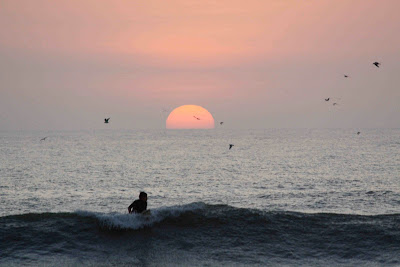We had a dramatic start to our time in Huanchaco. Arriving in Trujillo, seven hours after leaving Cajamarca, we decided that we would go a further twenty minutes onwards to Huanchaco, a quiet beach town. It seemed a more inviting prospect than another city stay.
We flagged down one of the many minivans that shuttle people from city to beach and back, and sqeezed in on the half-width bench, right behind the driver that they sometimes use if the van is getting really full. Somehow our back packs were hauled on and placed practically on the other passenger laps. They didn’t seem to mind. Balanced on this half bench and clutching onto as many of our bags as possible, the driver went about accelerating and breaking as hard as he could between passenjer pick-ups and drop-offs. He seemed to be trying to set a new world record for time taken to get to Huanchaco! Its not the first time we’ve experienced this mad dash to pick up passengers while at the same time trying to counter the lost time in actually having to stop to pick someone up, but its usually best to have a proper seat and something to steady yourself with.
After getting into the spirit (of being thrown around in the back of a van after a seven hour bus journey) – its your only option really – we arrived in Huanchaco and, as quickly as possible, hauled our belongings out of the van before it sped off again. Unfortunately, there was an old lady waiting to get on after we were out of the way, but the driver had not seen her. In a miscommunication between the conductor and the driver, the van accelerated off with the lady half on. The sliding door knocked her to the ground in dramatic fashion and then the van stopped, the driver realising what had happened.
We helped her to her feat and seeming unhurt – these old Latin American ladies are made of strong stuff – she made another attempt to climb in, while her friends outside the restaurant gave the conductor an earbashing about it. I was left feeling surprised I had not seen this happen before.
It was already dark and we didn’t want to traipse around for too long, so we checked into a very cheap hostel called My Friend. The good atmosphere and the equally cheap food offers in their restaurant - it was all about the pasta dishes for under $3, including drink and garlic bread – meant we took a room and ordered some of the aforementioned pasta.
After a walk along the sea front we returned to our room and discovered a newly hatched nest of cockroaches. But at first I thought it was the odd one or two and as they were fairly small, I went on a killing spree. Sophie then noticed Mommy and Daddy cockroach hiding in the gap between the door frame and the wall. We then realised our efforts to kill were futile, there were plenty more babies where they came from! During my stay at My Friend, I didn’t want to have to befriend these guys too.
We found another hostel. It wasn’t as cheap, but it was clean and had a distinct lack of crawley “friends.” I explained to the staff at My Friend that one or two you can expect, but lots of cockroaches isn’t what anybody wants and they understood. It wasn’t a bad place. The restaurant really was great there and, to a certain degree, there isn’t a lot you can do if cockroaches come to stay, until after they’ve been noticed.
We decided to stay in Huanchaco for a few days, which quickly turned into a week. The place was very relaxed and it was an ideal temperature, hot in the sun, but cool in the breeze. It wasn’t the best beach you’ll ever find, but it wasn’t too crowded, especially being low season, meaning you could always get shade if needed. But Huanchaco is very much a surf destination. There are some really impressive waves, and some equally impressive surfers on them. The waves break at a left hand 45 degree angle to the shore, meaning they can surf down the coast in one long stretch. One surfer couldn’t understand why we had come to Huanchaco if it wasn’t for surfing. Sorry to go against the grain on that one!
Country Notes and Tales From Travellers
13 years ago


































